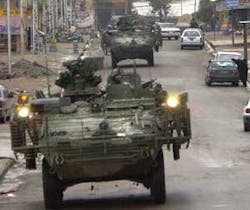By John McHale
ARLINGTON, Va.—Engineers at Cisco Systems have developed router technology through their own research and development that heals broken or weak network connections in military on-the-move applications.
A broken cell phone or Internet connection can cause major headaches for everyday consumers, but such interruptions can be life-threatening for warfighters in land, sea, or air platforms, says Pat Ryan, director of defense initiatives for the Cisco System Global Government Solutions segment located in Arlington, Va.
The basic problem to be solved was how “to get two entities to talk to each other when they are in the same vicinity without having to go through satellites and other uplinks,” Ryan says.
Engineers at Cisco looked at solving the problem through ad hoc networks, Ryan says. Ad hoc networks deliver Internet Protocol (IP)-based voice, video, and data to users who may be operating outside of a typical fixed-network infrastructure—such as a U.S. Army Stryker vehicle in a remote desert in Afghanistan.
Typically these vehicles have three nodes of communication—“satellite, air, and line-of-sight,” Ryan says. Today when one of those nodes goes down or the signal weakens, the systems do not switch to one of the other nodes, and voice, video, and data applications are lost, he continues.
The scenario is similar to a broken desktop computer wireless Internet connection that loses connected applications and related data, he says. This is much more serious in the military, where data lost from applications like video reconnaissance, blue/red force tracking, and targeting coordinates for fire control could mean the difference between life and death.
Cisco’s solution, called Radio Aware Routing, “heals these broken or weak connections,” Ryan says. It is self-healing because it seals the connection that may be breaking, he explains. “It does more than heal the network, it prevents and cures the disease,” Ryan adds.
Basically the routers are alerted so they can switch to another node to continue uninterrupted communication, Ryan says. It uses the Request for Comments (RFC) 4938 standard as the mechanism for relaying the network status of each node to the router, he says.
The RFC 4938 is a new open standard, authored by Cisco, which deals with merging IP routing and mobile radio communications in ad hoc networking applications.
According to the Cisco data sheet the “radio-to-router open standard solution employs IP—Point-to-Point Protocol-over-Ethernet (PPPoE) sessions—“to enable intra-nodal communications between a router and its partner radio.”
Military radios in vehicles such as the U.S. Army Stryker will ensure radio voice, video, and data connectivity through Cisco Systems’ Radio Aware Routing technology.
RFC-4938 also provides faster convergence and optimal route selection to ensure sensitive traffic is not disrupted, “reduces the impact on radio equipment by minimizing the need for internal queuing/buffering, and provides consistent quality of service for networks with multiple radios,” according to the data sheet.
The Cisco routers with this capability include the 3200 Series rugged integrated service routers, as well as the 2800 and 3800 routers.
Cisco has partnered with radio companies, such as Harris RF in Rochester, N.Y., to further develop the technology, Ryan says. Harris is known for its Falcon II and III software-defined radios (SDRs).
“Software-defined radios are important for determining the proper waveform,” but this new router technology will ensure the radio itself stays connected and the network data reliably transmitted, Ryan says.
“Cisco went a different path,” by developing the technology themselves, Ryan says. Government programs and requirements “do many admirable and good things” by acquiring technology and locking in standards, but the process can take many years, he continues.
Ryan says Cisco’s strategy “moves at the pace of technological change,” rather than following the requirements of a seven-year government program. Cisco designed this system in under a year using commercial off-the-shelf technology, he adds. “It is absolutely exciting,” Ryan says.
As usual with Cisco, the technology was developed for use in commercial and military markets, with the larger one being commercial, Ryan notes.

